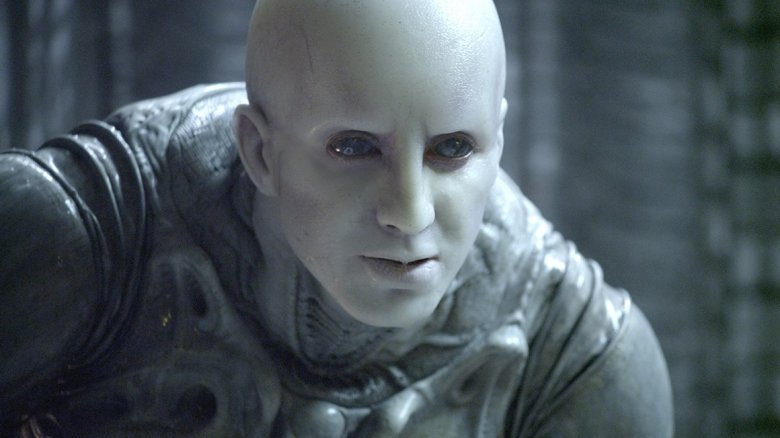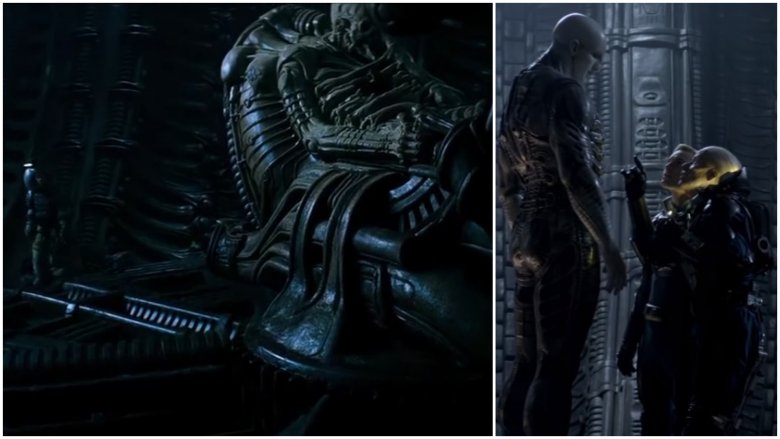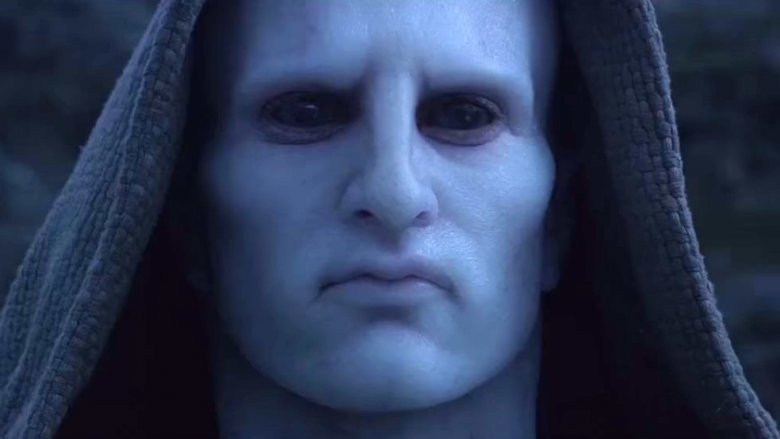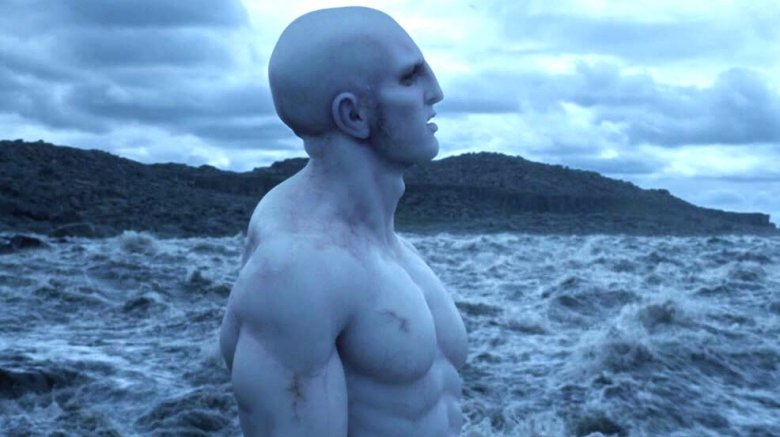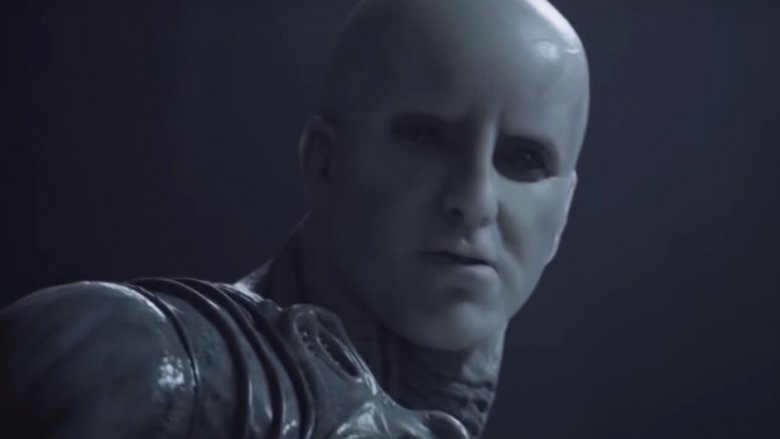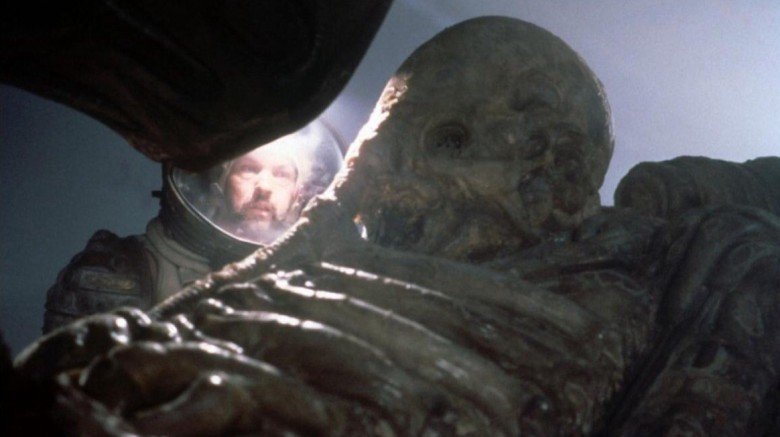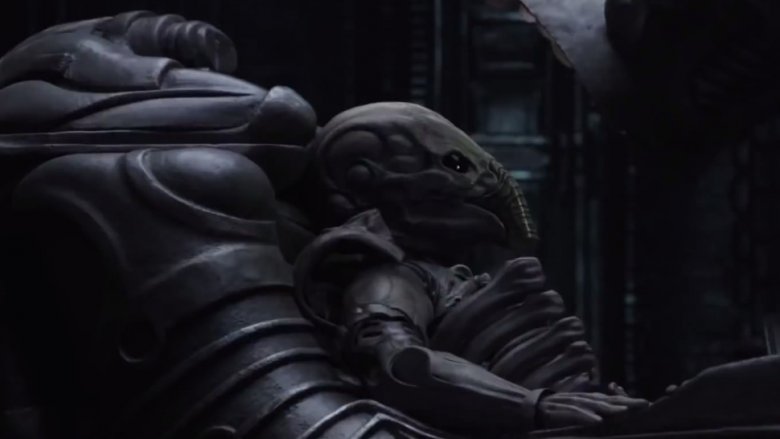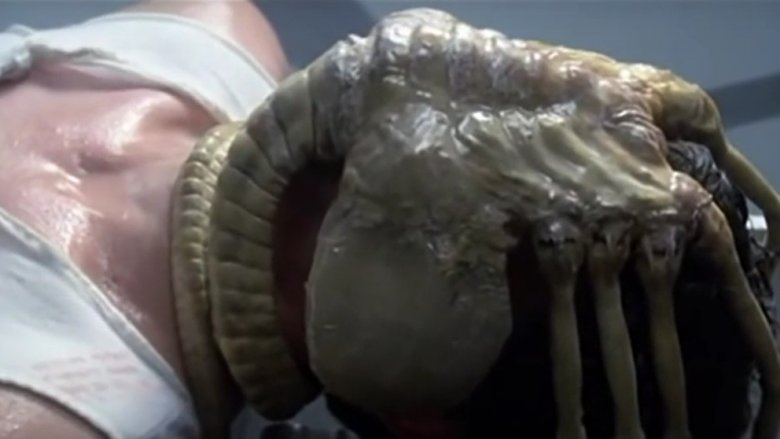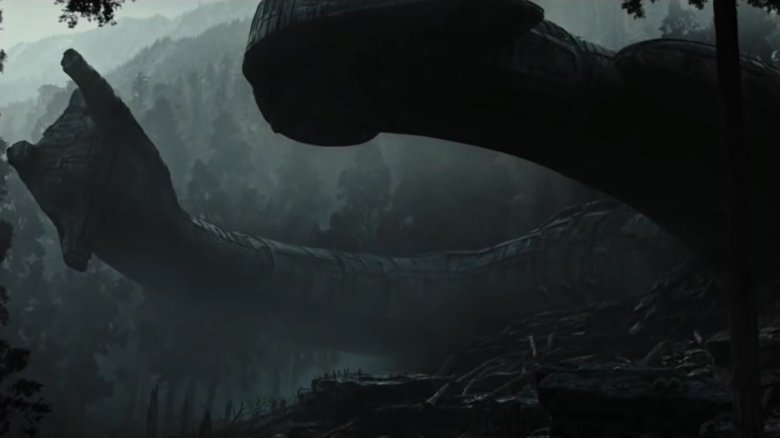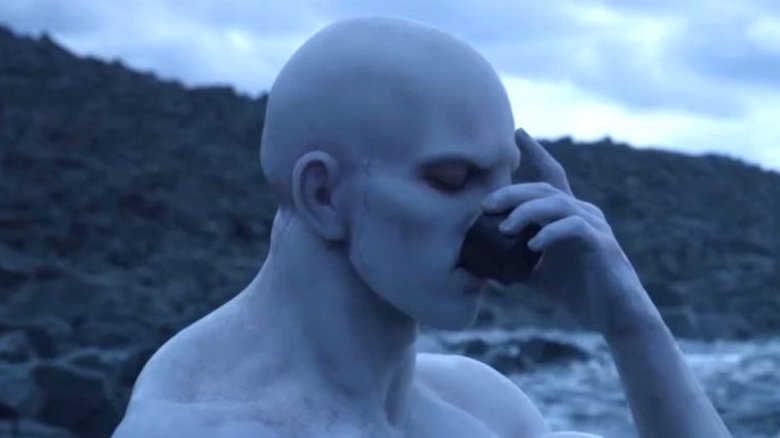What We Know About The Engineers In The Alien Franchise
You had questions after Prometheus, many of them revolving around the Engineers and their genetic meddling, super-strength, sci-fi Bio-Suits, sometimes-blue skin, and those hologram ancestors from the Great Beyond hiding inside their ships' navigation systems. Now that you've seen Alien: Covenant, you might be more confused than ever about our mannequin-headed overlords from outer space.
Let's do this. Here's some stuff you might not know about Alien's other aliens.
They're wicked tall
Engineers are enormous. Long before we met the xenomorph for the first time in Alien, we saw evidence of its destructive work in the form of the dead Pilot in the derelict ship. With the chair, the Pilot set piece was 26 feet high. The Pilot himself is approximately 15 feet tall. If Prometheus had followed Alien's lead and used the original dimensions, they would have been even taller, yet the Engineers from Prometheus stand roughly 10 feet on average. Are we supposed to believe that fancy armor accounts for a third of the Pilot's height?
Meanwhile, the Last Engineer from Prometheus is just nine feet tall. (When you can say an alien is just nine feet tall, you're dealing with a giant species.) Alien: Covenant adds some more diversity to their height range, but they're still really tall.
They're big, bald-headed MacGuffins and sometimes they're blue
It's clear that the Engineers have more in common with one-size-fits-almost-all-giants sized plot devices than fleshed-out characters. Why aren't there hologram flashbacks in the derelict ship in Alien? What makes Weyland think they can grant him immortality? How do they maintain such musculature in hypersleep? They're more like MacGuffins than characters.
Prometheus' Engineers and Alien: Covenant's Engineers look noticeably different, to the degree that some reviewers pondered whether the beings David slaughtered were even Engineers at all. (On May 24, 2017, Ridley Scott spelled it out: they were indeed Engineers.) It's almost like the Engineers in Covenant were themselves engineered to look more like us—the better to elicit our pity when David destroys them all—whereas the evil Last Engineer looks strange, if not demonic.
Upon closer inspection, though, the Engineers' appearance changes from shot to shot and scene to scene in Prometheus. The Last Engineer, the one who pops out from hypersleep to rip David's head off, looks gray in the face. Why are they sometimes blue and other times more like porcelain? Standing in his Jedi costume against an idyllic blue sky, the Sacrificial Engineer virtually blends in like a chameleon...or a Predator. Wait—are Engineers part Predator?
Do neomorphs even lift?
The Engineers are the buffest aliens in the Alien franchise. In Prometheus, in particular, they seem to have stepped out of classic art, like a member of Blue Man Group as envisioned by Michelangelo. A replica of Michelangelo's David stands in Weyland's home in Alien: Covenant. Furthermore, the theme of bioengineering Creation itself recalls Michelangelo's The Creation of Adam from the ceiling of the Sistine Chapel.
Humans' days of winning the Mr. Universe contest were over the moment the crew of the Prometheus met the Engineer in the Juggernaut. The scrawny neomorphs wouldn't even qualify.
They've got a ton of names
What's in a name? Partly due to the scope of the production and partly due to gratuitous rewrites demanded by producers and other executives, the big blue guys have been collecting aliases since their first outing.
On the first film, artist H.R. Giger referred to the ossified Engineer as the Pilot. Somebody else dubbed him the Space Jockey. Aliens director James Cameron bestowed upon him the title "Big Dental Patient," with all the rights and privileges thereunto appertaining. Additionally, this guy has been called an Ossian, a Mala'kak, and in the post-Prometheus era, an Engineer, one among many... Well, until David the antagonistic android went full genocidal maniac in Alien: Covenant.
It's entirely possible that the blue beefcakes from Paradise will be called something else by the time this article is published.
The Pilot in Alien
The first Engineer to appear onscreen in the Alien franchise is the Pilot, a fossilized chestburster victim that the crew of the Nostromo encounter on LV-426. As detailed in The Beast Within: The Making of Alien, budgetary limitations forced the filmmakers to cut the egg silo, a massive set piece, planned to house the xenomorph eggs, and move them into the derelict ship, now known to be Juggernaut. If not for the budget, there would have been a clear divide between the xenomorphs and the Pilot, and you wouldn't have to wonder why a seemingly advanced alien species would try to fly around with a cargo hold full of xenomorph eggs.
Engineers in the novelizations
Our favorite dead Engineer is nowhere to be seen in Alan Dean Foster's novelization of Alien, which goes into detail about the lives, thoughts, and motivations of the Nostromo's crew to a degree that the movie does not—and includes scenes cut from the movie. We learn from Ash that the xenomorph eggs come from LV-426, which contradicts the films. (For simplicity's sake, the novelization of Aliens, also by Foster, abandons this thread and, instead, follows the first film's continuity.) With not one but two Alien: Covenant-related novels slated for release in 2017, Foster will bridge the gap between Prometheus and Covenant, and maybe provide some answers about the blue guys as well.
There was a facehugger on the Pilot in the original Aliens script
In Alien II, David Giler, Walter Hill and James Cameron's first treatment for the sequel that later became Aliens, the Pilot is discovered among smoldering volcanic ash with a facehugger on his head. Obviously, the Pilot must have been "impregnated" the way Kane was, but it still would've been cool to see our suspicions confirmed onscreen. Given how the black goo has changed all the rules, that sort of canonical consistency would be pretty reassuring nowadays. In classic, action-focused Aliens style, there's little time to consider the ramifications of the scene, as "the floor... comes alive with scuttling spider-hand nightmares."
They made a lot more sense in Alien: Engineers, the original idea for Prometheus
MoviePilot offers an in-depth breakdown of why the first version of Prometheus might have made for a better movie. In Jon Spaihts' script, Alien: Engineers, the Engineers made actual, acid-for-blood, chitinous xenomorphs. As in Prometheus, Engineers make humans, Engineers make biological weapons, Engineers decide to destroy humans, Engineers are killed by their own destructive toys. In Alien: Engineers, the xenomorphs are "weapons." Furthermore, Alien: Engineers introduces the beluga-xenomorph, a "white, fleshy, vaguely transparent" version of the Engineer-borne ultramorph that resembles a neomorph from Alien: Covenant.
Spaihts' co-writer Damon Lindelof called Alien: Engineers "quite good" and then, in the same breath, decried it as "a dyed-in-the-wool Alien prequel" that was held back by "its own inherent prequelness." This apparently meant, among other things, renaming the spaceship Magellan Prometheus and replacing Spaihts' beluga-xenomorph with the paradoxical Deacon—the alien that hatches and then doesn't do anything because the movie ends. Bluer than an Engineer, smaller than a xenomorph, and dumber than anything in Alien: Resurrection, the Deacon hatches out of an Engineer's chest and lets out what can only be the alien equivalent of a red herring's preferred form of self-expression.
Their origins are purposely ambiguous
Lost mastermind Damon Lindelof had plenty of experience with ambiguous answers to longstanding pop culture questions well before he helped out with Prometheus. If you're a fan of conclusions that conclude, you probably felt pretty frustrated by the Lost series finale—and if Prometheus left you feeling lost, there's good reason for it.
Lindelof, who shares screenwriting credit with Spaihts, told The Hollywood Reporter that he's "drawn to an ambiguous storytelling that requires hard thought and work in the same way that the New York Times crossword puzzle does... Although it is genuinely painful and disheartening to hear people say that they hate it or that they wish that they'd never watched it in the first place, there's also something sort of sadistically cool about knowing that fights are happening out there about something that I've done." Remember that the next time you have a question about the Engineers.
They "engineered" human life, didn't they?
As Collider put it, Prometheus revealed that "[the Engineers] were headed [to Earth] to wipe out humanity when the organism they created turned on them, leaving behind the deadly tomb that the Prometheus crew finds." Dr. Elizabeth Shaw named them the Engineers in Prometheus, as she was under the impression that they had engineered life. The movie ends with David and Dr. Shaw lighting out for the territory of the Engineers' homeworld, the goal being "to better understand why they wanted to snuff out their creation of humanity," or so it seemed.
In May 2017, Ridley Scott corrected this common misconception, saying, "So we've reinvented the idea of Alien, I think, which is that Covenant gets us a step closer to who and why was this thing designed to make human beings. And if you think it's them [the Engineers], you're dead wrong."
Well, great. So, everything you've ever known about these big blue guys is a lie. Next thing you know, the black goo will turn out to be a mutant creatine supplement, weaponized to put a stop to doping in the Mr. Universe contest.
